THE MAGAZINE OF CALIFORNIA COLLEGE OF THE ARTS












Spring 2023
















Spring 2023



Artists, designers, and makers captivate with their precise ability to transform, combine, and use raw materials to create something new. Object and form take on new meaning and tell a story. In the hands of a maker, materials have the power of transformation.
Wood perfectly embodies this metamorphosis, revealing vividly how this material crosses disciplines and mediums at CCA. Designers steam bend wood into organic forms. Architects use it to create intricately detailed models. And artists transform bark into hand-made paper.
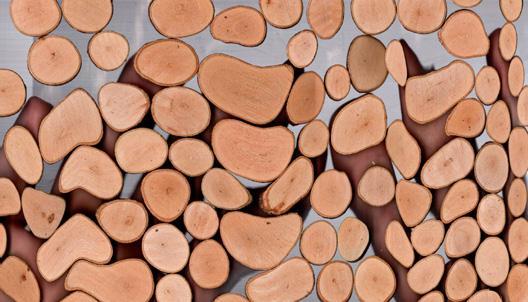
“This material tells the story of place—of indigeneity and origins, migration and colonization,” says Katherine Lam, chair of the Furniture program. “Engaging with wood in creative practice is an opportunity to position oneself within these histories
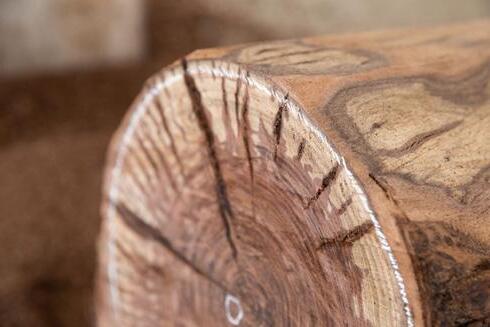


and in relation to others and the earth, as a way forward. Whether these histories are explicitly represented in the works themselves or act as a guide for relations with a community, this contextualization can shape teaching and learning spaces that support diversity of expression across disciplines.”

CCA students like Anke Larsen-Yskamp (BFA Individualized Studies 2022), who grew up among California’s redwoods and reclaims wood from already felled trees, weave messages of hope into their work. “Coast redwoods have an amazing ecological capacity for regeneration, and I chose to work with their branches, wondering how to reckon with a colonial legacy and environmental devastation yet still suggest some possibility of healing,” says Larsen-Yskamp.

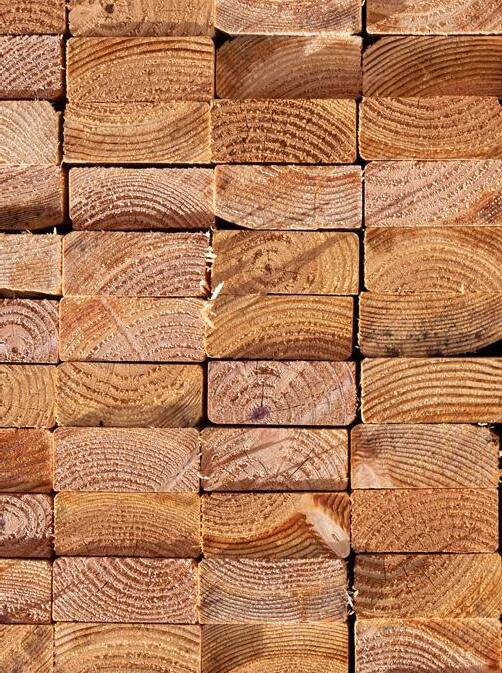
“THIS MATERIAL TELLS THE STORY OF PLACE—OF INDIGENEITY AND ORIGINS, MIGRATION AND COLONIZATION.”
KATHERINE LAM Chair, Furniture Program
Wood elements will also create a stronger connection to nature on the future CCA campus. In what has been a historically industrial neighborhood, the Double Ground campus expansion will include a low-carbon, mass-timber building design that will create an indoor-outdoor feel and connect the campus community to new green spaces.

As CCA grows and looks to the future, artists, designers, and makers continue to wield their powers of transformation with raw materials such as wood in new and exciting ways. They carry the legacies of the past forward as they invite wonder and imagination while making art that matters.

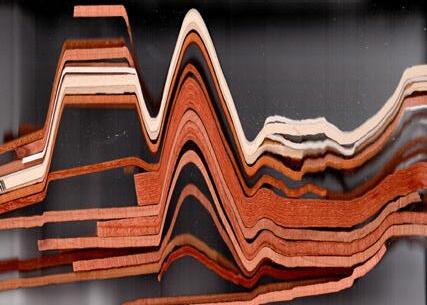
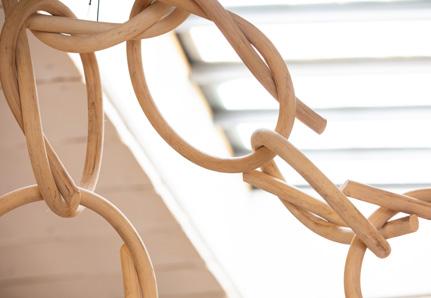
See what we’ve made on page 26.

In early February, CCA Board Chair Lorna Meyer Calas shared my plan to retire following the successful conclusion of a national search for the college’s next president. I encourage interested members of our community to monitor progress of the search and share your thoughts with members of the search committee. With the search underway, I want to take this opportunity to share a few thoughts and express my appreciation to the entire CCA community.
I love art schools and I love working at CCA—it has been my home for 25 years. In 1997, I was recruited to become the provost at CCA(C). My wife Dee and I left active careers at the School of the Art Institute of Chicago (Dee was the registrar and I was vice-president for academic planning and a tenured member of the painting faculty) to relocate to the Bay Area with our young family. We arrived excited about our new lives in California and the opportunities at the college, but also with some sadness leaving good friends and valued colleagues in Chicago.

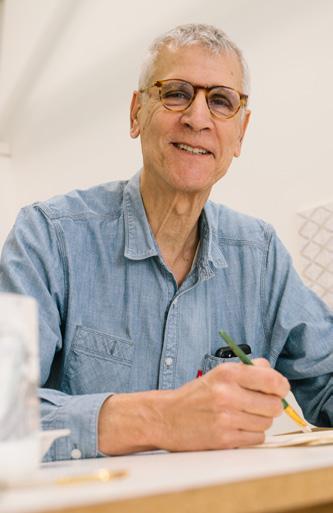
Now, after 10 years serving as provost and 15 as president, I know that the decision we made in 1997 was the best decision of my life. Ultimately CCA—and really any educational organization—is built around people. I consider myself lucky to have had the opportunity to work closely with an extraordinarily talented group of staff and faculty, and to be inspired every day by the creative work of our students and alumni. And no college president has worked with a more supportive and generous board of trustees and leadership cabinet. My heartfelt thanks go to you all!
Undoubtedly, CCA looks quite different from the college I joined in 1997, but the community— the talented, passionate, and committed people who collectively serve our educational mission—remain the same. They are the heart and soul of our college and working with these individuals has filled even the most challenging days with joy. Looking forward, I see a future filled with opportunities. With the Double Ground facility set to open in summer 2024, our long-range plan for a unified living/learning campus in San Francisco will soon become a reality. Having all our programs together will provide unparalleled opportunities for students to create and learn across disciplines and to explore new ways of working.
Nestled in the innovation corridor of one of the fastest growing sectors of the city, CCA students will study in the most environmentally sustainable and exciting urban art and design campus in the country. CCA is poised for a new era of inspirational teaching and learning, and I look forward to welcoming the next president to lead CCA’s exceptional creative community.
Warmest regards,
PRESIDENT STEPHEN BEAL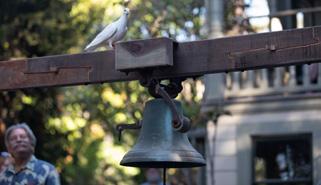

Fall 2022 was a semester of firsts for CCA. It was the first to welcome students to a fully unified campus with all programs located in San Francisco. This milestone felt even

On November 15, CCA launched both construction on its new campus with a “ground-making” ceremony and the public phase of the Maker/Meets/ Future Campaign. The campaign reimagines arts education for the future on a unified, expanded campus—a living, learning laboratory in the heart of San Francisco designed by MacArthur Award–winning architect Jeanne Gang. The campaign also supports public programming and diversification of the student body through scholarships, bringing students, faculty, and the community together to engage in the power of creative work.
The Maker/Meets/Future Campaign is only $3 million away from its goal of $123 million. If you would like to support building the college of the future and expanding access to CCA through scholarships, please visit cca.edu/future.
more momentous since it was the first time in two years that all classes resumed for fully in-person instruction. Students described their first days together on the unified campus as “beautiful,” “inspiring,” “lively,” and “full of school spirit.” It was also the first time the beloved Annual Blindfold Throwing Contest, now in its 32nd year, took place in San Francisco after the Ceramics program’s move from the Oakland campus. And in another first, CCA held its first Homecoming in San Francisco with a street party complete with food trucks, music, a petting zoo, and the Holiday Fair.
Even as we celebrated the unification of CCA’s programs in San Francisco, we honored the past by coming together on the Oakland campus to show our gratitude to the place we called home for 100 years. To mark this historic transition, we rang the campus’s bronze bell, traditionally sounded at the beginning and end of each academic year, for the last time in Oakland.
Next time you are rushing through one of the San Francisco BART stations beneath Market Street and notice that the escalators are out of service, don’t get cranky—get curious! Stop for a moment to check out the vibrant graphic designs enlivening the construction barricades. CCA’s own Hyunsoo Kang and Walker Lambert (both Graphic Design students) teamed up to create colorful graphics for some of the more than 40 barricades erected as part of the renovation of BART station escalators.

The project came out of TBD*, CCA’s in-house design studio led by instructor Eric Heiman that pairs students with
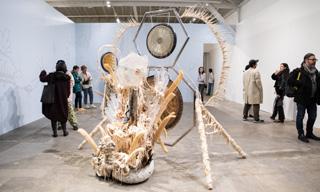
CCA made the honor roll! The ALL IN Campus Democracy Challenge named CCA one of the best colleges for student voting. This is thanks to Creative Citizens in Action (CCA@CCA), the campus initiative that weaves creative activism into the life of the college. To make the honor roll, colleges had to demonstrate a commitment to increasing student voting over the course of the past four years.
clients for real-world graphic design experience. Working with BART staff, Kang and Lambert developed three different designs that they hope offer moments of delight. And there are surprises as well: point your phone at one of the QR codes incorporated into the designs for an augmented reality experience!
Drum Listens to Heart, a multilayered three-part exhibition on view at the CCA Wattis Institute for Contemporary Arts for most of this academic year, took percussion—as elemental as the human heartbeat and as eternal as the beating of a drum—as its point of departure. And then it traveled widely. Over the course of six months, the expansive exhibition brought together an international roster of artists who explore symbolic, historical, or social manifestations of the percussive through a variety of media. Related events, including live music, art performances, and lectures, offered other avenues for experiencing the aesthetic, expressive, and political potential of drumming and rhythm.
Nationwide, according to exit polls, young voters turned out in high numbers for the 2022 midterm elections, where their votes made a difference. Issues that directly affect college-age students, from abortion rights to climate change to student debt relief, were motivating factors. Campus initiatives like CCA’s played a role, too, by spearheading voter registration, education, and turnout campaigns. Facilitating this democratic engagement is just one way CCA@ CCA is supporting students to actively participate as creative citizens in their communities.
“I wanted to see how a vocabulary borrowed from music might activate new layers of meaning for visual artworks,” says Anthony Huberman, the former director and chief curator of the Wattis Institute who conceived and organized the exhibition. “It didn’t try to ‘illustrate’ or ‘explain’ what percussion is, but established a rhythm between specific works that invited viewers to recognize percussive forms in new and surprising places.”

CCA is honored to announce $4.7 million in new gifts to support excellence, diversity, and innovation in the arts and design fields. A $1 million gift from the Gensler family and a $1 million gift from the global architecture and design firm Gensler are earmarked to support design innovation and promote diversity, social justice, and environmental sustainability through the newly established M. Arthur Gensler Jr. Center for Design Excellence. An additional $2.7 million gifts from Amazon, Z SUPPLY Foundation, and an anonymous donor will fund scholarship programs that support the enrollment of more than 20 students from diverse backgrounds annually.
In addition, CCA has reimagined its Diversity Scholarship as the Visionary Practice Scholarship, which will be awarded to undergraduate students from diverse experiences who have bold ideas, a story to tell, and a creative vision. Together, the Gensler Center and these new scholarships will make a significant impact in broadening access to education at CCA.
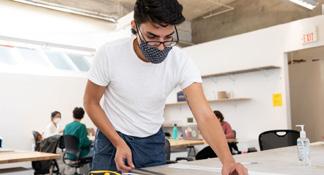
CCA opened its new Campus Gallery in Blattner Hall in January 2023 with the inaugural show Recognitions / 认 • 知, a solo exhibition by Christine Wong Yap. The exhibition featured three new social practice projects between alum Christine Wong Yap (BFA Printmaking 1998, MFA Printmaking 2007) and the Edwin and Anita Lee Newcomer School (EALNS)—a one-year language immersion elementary school, serving Chinese-speaking recent immigrants.
In one project, Christine reinterpreted student drawings of airplanes, a symbol of their emotional journey to the U.S., into three-dimensional tactile, comforting plushies. Visitors to the show could also interact with a
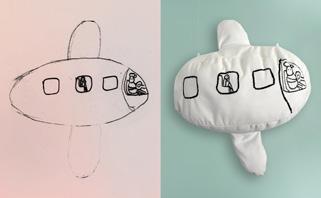
large puzzle of a map of San Francisco, illustrating this vibrant community.
This exhibition was generously supported by the National Endowment for the Arts, Grants for the Arts, and the Deborah and Kenneth Novack Creative Citizens Program Series.
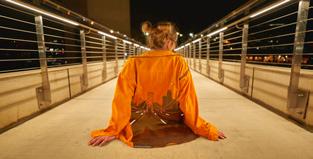
Ingrid Henderson (MFA Fine Arts) wants to challenge the idea that art is untouchable. So for her thesis project, she began creating fabric collages sewn onto clothing as a form of social sculpture; with each item of clothing meant to be passed from person to person. Last fall Henderson had the idea that superstar singer Billie Eilish should be the first person to wear
one of these shirts. Henderson spent more than 200 hours collaging and embroidering the orange shirt Hills Burn in California, Part 3, whose title is taken from an Eilish lyric. But how to get Eilish’s attention? That’s where TikTok came in.
Henderson posted videos of her making the shirt a few days before the concert, initially only expecting a few hundred views; by the day of the concert she had more than 100,000. Today, the video has over 700,000 views. Although Eilish didn’t don the shirt during the concert, Henderson still feels the project was successful. She says, “As an artist, I feel like I have succeeded when a piece has drawn people and compels them to talk about it.”

Illustrator Maia Kobabe (MFA Comics 2016), who uses e/em/eir pronouns, recently found emself at the center of the nationwide controversy over which books belong on school library shelves. The CCA alum’s 2019 graphic memoir Gender Queer movingly charts eir personal story of coming out as nonbinary. Kobabe had set out to write the book as a way to communicate that experience to friends and family, and also hoped it would reach other young people who were struggling with gender nonconformity. Gender Queer earned a passionate following, good reviews, and multiple awards.

Then, in 2021, amid ramped-up efforts by certain school boards to ban books they claim are inappropriate for children or teens, Gender Queer became the most challenged book in the United States for its honest depiction of sexuality and gender fluidity. Ironically, the controversy surrounding Gender Queer has raised the book’s profile and increased its sales. And Kobabe has given interviews in the New York Times, NBC News, the Texas Tribune, and others affirming the importance of coming-of-age works such as Gender Queer that speak to youth honestly and openly.
CCA is proud of the many students who were recognized with awards and other honors in 2022. Graduating Architecture students Venessa Davidenko, Caine Knuckles, David Rico-Gomez, and Eve Tobey and Interior Design graduates Suyang Yao and Xiyue Zhang were named among the top 100 students graduating in their fields by Metropolis magazine’s 2022 Future100. Owen Fernando Patia (Interior Design) received two awards: Emerging Light Designer of the Year from @lightecture and a 2022 LIT Lighting Design Award for his project Aqua.
CCA’s 2022 Ronald & Anita Wornick Award Exhibition, which recognizes
students in the wood arts, featured the work of award recipients Ina Trayanouskaya (Furniture) and Nicole Wong (Furniture). The Society of Illustrators selected the work of four CCA Illustration students—out of 6,721 entries—for inclusion in its 2022 Society of Illustrators Student Scholarship Competition exhibition: Tony Bernardo, Jade Howe, Brian Kwon, and Xiangzi Xu; additionally, Howe was one of only 33 students awarded a scholarship. Finally, a mosquito net made from lemon rinds by Zahra Jajarmikhayat (MFA Design) was named overall winner runnerup in the 2022 Biodesign Challenge. Congratulations!

1. m ural by Steffi Lynn depicting Bay Area species at risk of extinction. Powell Plaza, e meryville. Photo by Yoshi Yanagita. 2. Left to right: Alexandra (Alex) u nderwood and Joey Rose (both BFA Illustration 2017), organizers of Sea Walls e meryville. Photo courtesy of the artists. 3. The artist e voca1 calls attention to rising seas. 4051 San Pablo Avenue, e meryville. Photo by Yoshi Yanagita.
Murals by Sea Walls: Artists for Oceans can be spotted all over the world in a wide range of communities, from the dense, urban streets of Toronto to the coasts of New Zealand, and from the Canadian Arctic to the beaches of Mexico. The creative outlet of the nonprofit organization PangeaSeed Foundation, Sea Walls “brings the message of ocean conservation into streets around the world.”
Two years ago, CCA alumni Joey Rose and Alexandra (Alex) Underwood (both BFA Illustration 2017) began their journey to splash public art across Emeryville, California. Their project is the local iteration of the international Sea Walls: Artists for Oceans mural festival, which boasts over 400 murals across 18 countries to date. In September, Rose and Underwood debuted Sea Walls Emeryville with 15 murals painted by local and international artists, each focusing on a theme connected to the oceans and the environment.
When people think of Emeryville they often picture Pixar Studios, or the blue and yellow IKEA rising behind a freeway interchange. But those images both conceal and highlight for Rose and Underwood why Emeryville is emblematic of some of the issues that concern the environment in the Bay Area and California today.
“We moved to Emeryville because I did a public art piece with the city about five or so years ago, and I was so struck with how much the city and community supports public art,” says Rose. “And then once we moved here we realized there was a marina right across the freeway. We’d walk our dog during the pandemic and notice this disconnect: the freeway cuts people off from the water.”
Rose and Underwood sought to change that narrative and focus on what connects people. “Art is a tool to spark change,” says Rose. “I’m not a scientist, but the tool I have is art. Using art to get people involved, that’s what this is all about.”
Each Sea Walls festival takes a local form, with murals commissioned under a set of regional themes and topics. Rose and Underwood curated a thematic palette for the 17 Sea Walls artists to draw from as they conceived their murals. These themes included local endangered species, sea level rise, pollution and landfill, environmental justice, and Indigenous land stewardship.
“The Bay Area is the second largest estuary on this side of the continent. It’s really an important thruway for different species of birds, different migratory fish,” says Rose. “These intersections of different habitats are some of the most biodiverse ecosystems we have. And it’s where we are, here in the Bay. We need to really make sure we protect it.”
The artists who brought Emeryville’s streets and walls to life with art include local and international creatives who came to the city to put their original take on the various themes connected to the San Francisco Bay ecosystem. “A lot of these artists were our icons while we were going to CCA and starting our mural careers. We really look up to these people and were so excited to meet them in person,” says Underwood.
Steffi Lynn, an artist based in Austin and New York City, for instance, installed a mural at Powell Plaza (5707 Christie Avenue) to highlight Bay Area species at risk of extinction.

Her bright, colorful work features endangered salmon, birds, and other marine species indigenous to the San Francisco Bay. “I was really excited to meet Steffi,” Underwood says. “She has a huge following on Instagram [@haveanicedayy_] and is an amazing typography artist—she makes it look easy.”
Another muralist whose work focuses on endangered species is the British/South African artist Sonny Behan. (His work appears at 5400 Hollis Street.) Behan creates hyperrealistic images that can appear to leap off the wall. “I remember being on Instagram looking at Sea Walls artists all through school, just aiming to be a Sonny Behan. He’s done many Sea Walls activations,” says Rose.
Talented local artists were also instrumental in bringing their unique lens to Emeryville’s murals. Oakland and Santa Fe–based artist Felicia Gabaldon responds to the


erasure of Indigenous history in the city’s past in her mural at 1460 Park Avenue. “Felicia worked with Sogorea Te’ Land Trust, an Ohlone Indigenous-run, women-run organization working to protect Indigenous land here,” says Underwood. “And Felicia, who is Indigenous as well, added to her mural from that collaboration, which made a very impactful connection.”
Rose and Underwood hope that the work the local community and visitors to Emeryville see on the walls of the city will inspire people to pause and think. “Hopefully this inspires some people to dig deeper into the history of the places they live,” says Rose. “We’re not separate from the ecosystem. I hope these murals inspire people to look into their community’s history, to educate themselves.”
Jasmin Darznik grew up in a world full of stories through books she eagerly read as a child. Her family left Iran for the United States when she was five years old, eventually settling in the San Francisco Bay Area. Reading, she discovered, offered a safe haven for a child in a family on the move. One day, she would write her own stories.
“I THINK IT’S IMPORTANT TO BE BRAVE. AND I WAS ABLE TO BE BRAVE BECAUSE I HAD DEVOURED SO MANY MEMOIRS THAT DID THE VERY HARD WORK OF TELLING THE TRUTH.”
JASMIN DARZNIK Chair, MFA Writing



Going away to college is a rite of passage for many young adults. It’s a time when they head out into the world to explore their lives and chart their careers. Many college campuses, including CCA, offer housing and programming to ease students into this new chapter. CCA recently expanded its on-campus offerings to serve a fully residential community with the opening of Blattner Hall in 2018 and Founders Hall in 2020. The college’s return to fully in-person instruction for fall 2022 offered a peek into how students are building community and taking advantage of a centralized urban campus.
Two students—Sidney Turner and Robin Parks—offer a glimpse of how they make a home on campus, opportunities to expand their practice by living at CCA, and why there is nowhere quite like San Francisco.


With different roommates over the years, she notes the importance of having open communication and adjusting to different lifestyles. “It taught me how to understand someone else’s perspective,” she says.
Turner also found joy in making memories that will last a lifetime. Because of CCA’s location in San Francisco, Turner takes time between her films and classes to spend time with friends, from going to the beach to a night out dancing. “We do spend a lot of time at the beach,” she says, “When we have the time, we try to make some really, really fun memories.” The campus hotspot, however, is CCA’s dining hall, Makers Cafe. “It’s the most popular hangout hub for everyone to come together,” she says.
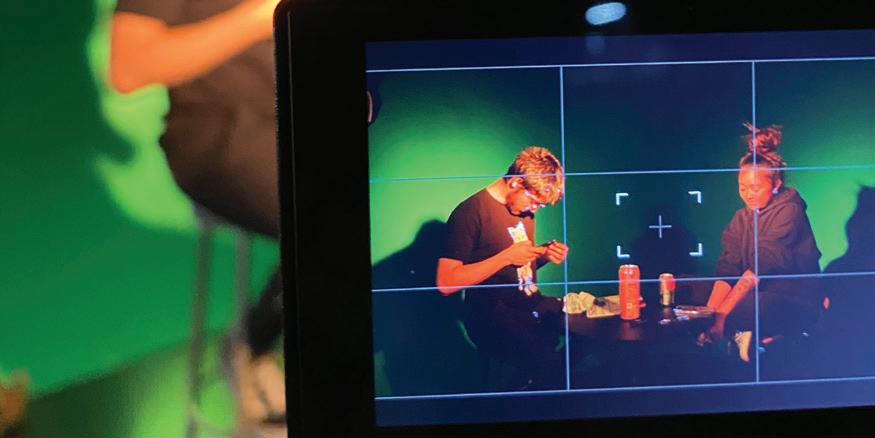

Sidney Turner came to CCA from Houston to study filmmaking and has found many opportunities to make new friends, take on student leadership roles, and use the city as a backdrop for her work. She lives in Founders Hall right in the heart of campus, which has taught her how to have brave conversations.
Living on campus also provides Turner with the resources and equipment she needs right at her fingertips. Between the Media Center and the Film Cage, she says, “It has everything you need whether you’re just starting out or you’re getting your practice to the next level.” And then there’s the added bonus: location. In San Francisco she can choose from any number of diverse places to set her film. “There’s so much to explore in the Bay Area and different neighborhoods can look totally different from the next,” she says. “Those things create the aesthetic of the film; it creates more opportunities, possibilities, and ways to take the direction of your work.”
Like most CCA residents, Turner says that one of the most important things about living on campus is the extra time it gives her to focus on her studies. “Everything you need is right next to you.”

Robin Parks is an Illustration major and Bay Area native who grew up in Castro Valley and went to high school in Oakland. A natural self-starter, she has taken on many student leadership roles at CCA including as a residental assistant (RA) in Blattner Hall and a program assistant/senior coach for the Learning Resource Center. In her spare time she enjoys the vibe of San Francisco and taking advantage of the many free museum weekends the city offers. Parks transitioned from high school to college with relative ease, noting that, “it was the shift in independence that I had to think about the most.”
Set to graduate in 2023, Parks is focused on what comes next and is diligently working with feedback to develop her work. She can often be found working in the Illustration homeroom, sometimes in the early hours to get a jump on her day. “The Illustration homeroom is just one of those places that’s always open, and it’s right here,” she says. For students in Illustration and other programs, the
Risograph and the Flat Lab are other convenient on-campus resources important to getting the work done, just steps away from home.
Parks also takes time to enjoy her neighborhood in San Francisco. One of the popular after-school activities for her fellow Chimeras are hangouts at SPARK Social, a food truck park with an adjacent mini-golf course in Mission Bay.



“SPARK Social became the spot among my group of friends,” she says. “I also take myself out to museums, visit the many shops in Union Square, or even just hang out in Makers Cafe or one of the classrooms.” She recalls the height of the COVID-19 pandemic during the shelter-in-place orders and says, “I realized that I want to make the most of my time here before I go on to the next thing.”
The CCA campus serves as a hub of activities for professionals in the industry or social events, which is important to Parks. “I feel more involved by living on campus,” she says. “And I’ve actually connected with really wonderful professionals in the working world just through hearing them speak at campus events or in the classroom.”




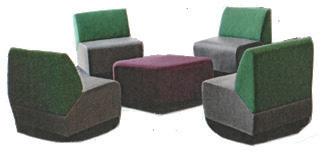





Over the course of CCA’s more than 100-year history, the college has seen profound change, growth, and transformation. Our ambitions lie in the future of what art and design can be and what it can do to impact the world.
Our campus looks much different now than just a year ago and will continue to evolve as the years progress. With unification in San Francisco and the forthcoming Double Ground expansion, we’ve made opportunities for students to connect in and out of the classroom in new and surprising ways. The city is our studio. And the campus is the hub connecting makers to the world.



This is our CCA, today.



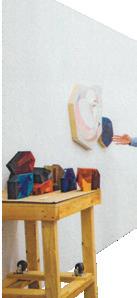














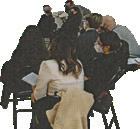





 CCA Campus Gallery
Double Ground—Backlot Construction
RayKo Photo Center
The Nave
MFA Studios in the Dogpatch
CCA Campus Gallery
Double Ground—Backlot Construction
RayKo Photo Center
The Nave
MFA Studios in the Dogpatch
We talked with Jeanne Gang, founding principal of Studio Gang, about her firm’s design for the innovative centerpiece of our campus expansion, slated for completion in 2024. This sustainably designed building, which hosts an outdoor plaza and welcoming green spaces, will foster a sense of connectedness and community while re-envisioning the future of art and design education.
This was a dream project for me as a designer. It was exciting to think about what kinds of spaces artists and designers need for creativity and making. I know that proximity to other makers—the creative energy that flows
between people—is really important. So, encouraging collaboration between people and disciplines emerged as the ultimate design goal. We asked, “How can architecture make collaboration more fruitful? How can it amplify creativity in a space?” We thought about how to create situations where students bump into each other serendipitously and how to bring them together to work on projects, to come up with new ideas, and to make those ideas real.
We also asked what was going on in the area surrounding the campus—how could the design facilitate partnerships and collaborations at the urban scale?
The building aims to engage the primary people who use it, the CCA community and their guests, and also to become a center of buzzing activity in the

neighborhood, drawing people in and sending CCA students and faculty out to spark new relationships.
At nearly every single college and university, disciplines tend to be siloed. This is a problem, especially because it restricts our ability to solve complex issues and exercise our full creativity. The design concept for the CCA campus seeks to help “de-silo” the school and fully unify it. First, it creates one continuous level for all of the physical making spaces—the shops—and their shared tools, materials, and equipment. This makes it very easy for students to meet people from different disciplines and to foster collaboration. Then, atop
this robust maker level, the design adds a green outdoor layer for recreation and gathering. This gives everyone at CCA a shared place to come together as a community, increasing the feeling of a unified campus that was previously missing.

There are two key factors to consider when designing sustainable architecture: how much energy the building uses (operational energy) and how much energy went into making the building materials and constructing the building (embodied energy). To design the CCA project, we started by saying, “Let’s orient the building for passive heating and cooling, so it’s intrinsically laid out to use as little energy as possible, and then let’s start the equation of further lowering energy use.”
The continuous shop level is central to the radically passive energy strategy we adopted, because rather than spreading out all of these spaces and the resources they require, it is sharing load, sharing energy, and sharing tools—all in one zone. It also saves on building materials and construction. The thick roof of this level provides great insulation, which saves more energy, and allows for the occupiable green level above. The deep
covered porches that extend the shops into outdoor maker spaces also serve to shade the building and provide other thermal benefits. So, all of these strategies add up to a very low-energy building.
AN ART AND DESIGN SCHOOL?
We wanted to make a “creatively hackable” space, one that can adapt depending on changing uses. We thought in terms of an optimal column grid, one that can be reconfigured for the future and for different ways of making art that we don’t even know about right now! Defining the column grids, and then deciding to avoid covering the columns and beams in layers and layers of material—just letting them be lovely bones—were crucial to creating a flexible space. This way, you don’t have to cut into drywall to change the interior. You can just move partitions between the columns, which is much simpler and less costly. Its flexibility will serve the college well in the future because the layout is able to change according to the ways that students want to work, the different kinds of teaching that is taking place, and the many directions for collaboration.
“HOW CAN ARCHITECTURE MAKE COLLABORATION MORE FRUITFUL? HOW CAN IT AMPLIFY CREATIVITY IN A SPACE?”Jeanne Gang, founding principal of Studio Gang, speaks at CCA’s campus expansion ceremony in 2022.
HOW DID YOU THINK ABOUT THE ROLE OF THE BUILDING IN CREATING A HEALTHY ENVIRONMENT?
The well-being of students, faculty, and staff, and everyone else who comes to CCA, is central to the design. The San Francisco campus is in a semi-industrial neighborhood that lends itself well to becoming maker space, but it doesn’t provide all the other qualities and amenities that a typical college campus has, which support people’s health and wellness. That is one of the reasons why we felt it was so important to create a green upper layer for the campus, and to establish lots of ways that you can access the outdoors. With so many indoor/ outdoor connections, you can walk right out of your classroom and onto a covered porch, or you can enter a maker yard that opens right up from a shop, or you can continue a discussion with your friends outside in a green, planted space—or gather there to play Frisbee. The design allows the CCA community to enjoy all of these amenities that most campuses have, but here, they’re interestingly woven into the post-industrial urban context.
HOW DOES THE DESIGN INCORPORATE STUDENT INPUT?
Student workshops were key to our early design process. We spent six months listening, gathering input, and brainstorming ideas with the CCA community to understand how all of the different departments and people work, and to develop different spatial schemes that could support the unique needs and aspirations we heard. Students told us they wanted hybrid experiences in their art making—those who were learning welding also wanted to be able to work in the wood shop, for example,
and other crossovers. That was really exciting to hear and helped inform this unified campus with a unified shop space; everyone is able to safely access everything.
Another insight we gleaned from students is that it’s really important to them to have different kinds of spaces for different types of activities. It’s not all making at CCA; sometimes you need some quiet time and places to study. So, we thought about and designed a whole ecology of different spaces that are needed for students to feel comfortable and do their best work.
WHAT DO YOU THINK THE LEGACY OF THIS PROJECT WILL BE?
This project looks forward to what art making will be in the future. CCA has a self-critical attitude: If it’s not working, let’s change it, let’s evolve it. The building allows for exactly that. It will be a place where people want to come to make art for many, many years to come. It’s setting up the school for a very successful future.

“WITH SO MANY INDOOR/OUTDOOR CONNECTIONS, YOU CAN WALK RIGHT OUT OF YOUR CLASSROOM AND ONTO A COVERED PORCH, OR YOU CAN ENTER A MAKER YARD THAT OPENS RIGHT UP FROM A SHOP, OR YOU CAN CONTINUE A DISCUSSION WITH YOUR FRIENDS OUTSIDE IN A GREEN, PLANTED SPACE—OR GATHER THERE TO PLAY FRISBEE.”Renderings courtesy of Studio Gang.

Since the college’s earliest days, CCA has moved locations several times in support of a growing student body and evolving arts disciplines. Today, we carry forward this legacy while we ambitiously build upon and strengthen a cutting-edge, interdisciplinary art and design education. Here’s a look at where CCA has been and the future we’re making in San Francisco.
On November 15, CCA starts building the centerpiece of its innovative campus expansion, designed by Studio Gang and set for completion in 2024.

CCA unifies its programs in San Francisco and resumes full, in-person learning for the fall 2022 semester, after more than a year of remote and hybrid instruction.
The new on-campus residence, Founders Hall, partially opens at 188 Hooper Street, welcoming first- and second-year students. With Founders Hall and Blattner Hall, CCA can now house more than 700 students.

Blattner Hall opens at 75 Arkansas Street near CCA’s San Francisco campus. Made in partnership with longtime trustee Simon Blattner, this new building accommodates more than 200 continuing, transfer, and graduate students in apartment-style campus housing.

CCA announces plans to expand its campus in San Francisco and selects Studio Gang to lead the design of the new campus.


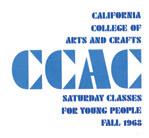
Macky Hall is placed on the National Register of Historic Places. Macky Hall and other historic buildings will be preserved, leaving a lasting legacy in Oakland.


Founder Frederick H. Meyer purchases the
James
estate in Oakland and leads a crew of students, faculty, and alumni that transform the rundown estate into a campus.
The college purchases a 2.5-acre vacant lot from Greyhound Lines, Inc. in San Francisco—the future site of its campus expansion.
Having outgrown its original location at The Studio Building in Berkeley, the school moves to a new home at 2130 Center Street in Berkeley.
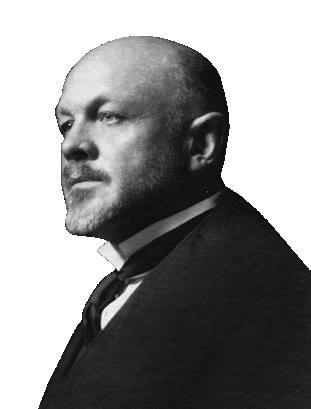


The college celebrates the opening of the San Francisco campus, formerly a Greyhound bus depot, giving a permanent home to the college’s Architecture, Design, and Humanities and Sciences programs.
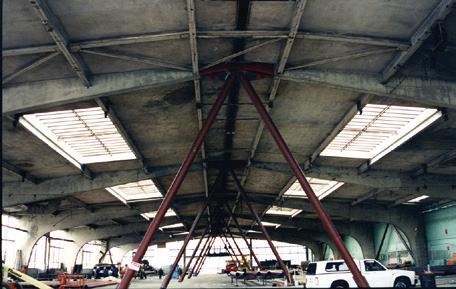
Timothy Aguilar (1962)
Cal Anderson (Interdisciplinary Design 1946)
Bobby Anspach (Fine Arts 2015)
Billy Al Bengston (1956)
Esther Davies (BFA Painting 1975, MFA Painting 1977)
Ellie Fidler (MFA Textiles 1984)
Sharyn Gayton (BFA Advertising 1970)
Debra Goodwin (BFA Textiles 1981)
John Hincks (Painting 1970)
Jamison Hunt (BFA Illustration 1997)
Louis Kiyoshi Ito (BA Applied Arts 1956)
Donald Jevons (BFA 1957)
Annette Kohlmeister (Interdisciplinary Fine Arts 1956)
Jimmy Hiroshi Koide (BFA Interdisciplinary Fine Arts 1954)
Wookjin “Jin” Kwon (student, MFA Design program)
David Kuebel (BFA Graphic Design 1975)
Christine Liskey (1972)
Bogna Lorence-Kot (Faculty)
Kari Marboe (Faculty, BFA Ceramics 2008)
Janice Marcin (BFA Interdisciplinary Design and Painting 1984)
John McHale (MFA Painting 1961)
Marianne Noland (BFA Interdisciplinary Fine Arts 1953)
Patricia Palmer (1971)
James Petrillo (Faculty)
Noriko Yamamoto Prince (BFA Painting 1956, MFA Painting 1957)
Asa Pritchet (1971)
Sheila Riley (Faculty)
Ruth Rippon (BAEd Art Education 1949, MFA Ceramics 1951)
Amy Schwartz (BFA Drawing 1975)
Amy Sims (Faculty)
Vanessa Slavich (MDES Interaction Design 2017)
Robert Smith (BAEd Art Education 1962)
Susan Thornberry (BFA Painting 1977)
Jean Woodard (Drawing 1972)
JANUARY 1–DECEMBER 31, 2022
$25,000+
Stephen Beal and Elizabeth Hoover
Ellen and John Drew
Koko F. Flowers (BFA Graphic Design 1970)
Lauren and James Ford
Nancy and Pat Forster
Jonathan Gans and Abigail Turin
M. Arthur Gensler Jr. Family
Lorrie and Richard Greene
Helzel Family Foundation
Janet Herrero
George F. Jewett III (BArch 1996)
David and Deborah L. Kirshman
Robin Rosa Laub
Joyce Linker
Chuck Marboe and Bonnie Hewson
The S. Livingston Mather Charitable Trust
The Family of Marie McHugh
Ms. Ann Morhauser (BFA Glass 1979)
Diana Nelson and John Atwater
F. Noel Perry
Cathy and Mike Podell
Rotasa Fund
Abby and Gene Schnair
Helen and Chuck Schwab
Kimberlee Swig
Judy Timken
Jack and Susy Wadsworth
Kay and Sandy Walker
Westridge Foundation
Diane B. Wilsey
Anita Wornick
$10,000–$24,999
Larry and Pam Baer
Johanna and Tom Baruch
Kimberly and Simon Blattner
Michael and Tammy Borosky
Dr. Thomas and Janice Boyce
Michael Bruce Thomas Bruce
Lorna Meyer Calas and Dennis Calas
Heidi Castelein
C. Diane Christensen and Jean M. Pierret
Wayee Chu and Ethan Beard
Penny and Jim Coulter
Catherine Courage
Richard and Jean Coyne Family Foundation
Daniele De Iuliis and Janine Wiedmer
Patricia S. Dinner and Family
Carla Emil and Rich Silverstein
Jessica and Matthew Farron
Emily Fisher and Evan Griswold
Randi and Bob Fisher
Aaron Gensler
Maria Giudice and Scott Allen
Mimi and Peter Haas Fund
Nancy Klehr
Byron D. Kuth, FAIA LEED AP and Elizabeth Ranieri
Miranda Leonard
Julie Lythcott-Haims (MFA Writing 2016)
Marsha Maytum, FAIA and William Leddy, FAIA
Nion McEvoy and Leslie Berriman
The Anthony and Celeste Meier Family
Mrs. Sarajane Miller-Wheeler and Dr. Calvin B. Wheeler
Mary Mocas (MFA Fine Arts 2016) and Marvin Tseu
Alexandra Moses
Owen and Ellengale Oakley
Brittany Pattner
Annie Robinson Woods and Montgomery Woods
Tara Rudman
Gene Savin and Susan Enzle
Chara Schreyer and Gordon Freund
Carol Swig
Marjorie A. Swig
Susan Swig
Alyssa Warnock (BFA Graphic Design
2001) and Todd Berardi
Ms. Carlie Wilmans
Carina Wong (MBA Design Strategy
2019) and David Chai
Robin Wright and Ian Reeves
Mary and Harold Zlot
Anonymous
$5,000–$9,999
Harvey Armstrong
Yosh Asato and David Baker
Sabrina Buell and Yves Béhar
Ralph and Donna Briskin
Maria and Eric Clothier
Carol Critchlow and Tim Davis
Sarah DiLullo
Robin Dintiman (MFA Fine Arts 1983)
Kevin Domecus and Laura Brucken
Rob Forbes
Jeffrey Fraenkel and Frish Brandt (BFA Printmaking 1979), Fraenkel Gallery
Stanlee R. Gatti
Maria and Chris Hemphill
Pamela and David Hornik
Lauren Kern
Sophia Kinell
Kaitlyn and Michel Krieger
Bryan Lamkin and Arianna Carughi
Rose and Richard Marboe
Meridee Moore
Michael Muscardini (BFA Printmaking 1972) and Kate Eilertsen
Deborah and Kenneth Novack
Nancy and Steve Oliver
Julie and Will Parish
Parker Family Foundation
Nancy and Paul Pelosi
Clint and Janet Reilly
Amnon and Katie Rodan
The Sage Foundation
Stanley Saitowitz
Catherine and Mark Sarkisian
Jessica Silverman (MA Curatorial Practice 2007) and Sarah Thornton
Robert P. Smith III* (BAEd 1962)
Amanda and Bruce Spivey
Robert Stein and Jessica Pers
John Wendler
Sonya Yu
Nancy and William Zerella
Anonymous
CCA is honored to recognize the following leadership donors who contributed generously to the college.
Robert G. and Judith G. Aptekar
Ursula K. Auerbach (BFA Ceramics 1977)
Susan Avila and Stephen Gong
Terri Bailard (BFA Environmental Studies 1973)
Darla and Richard Bastoni
Henry Beer
Andrew Belschner
Douglas Bernhagen (BA Applied Arts 1969) and Cathy Bernhagen
Ruth Berson
Jennifer and Doug Biederbeck
Sarah Bird (MFA Fine Arts 1994) and Scott Pofcher
Eli Bishop (MFA Comics 2017)
William Bivins, Jr. and Lynn Fuller
Charles Bloszies, AIA
William Bondy
Rena Bransten
Leslie Buchbinder
Lorne and Rochelle Buchman
Jack Calhoun and Trent Norris
Tammy Rae Carland
Willa and Lawrence Chao
John Clawson and Teri Behm
Susan Coliver
Penelope Cooper and Rena Rosenwasser
Modesto Covarrubias and Dennis Markham
Rose Anne Critchfield (BFA Painting & Drawing 2005) and Steve Cohn
David Darling
Lara Deam
Lois M. De Domenico
Lisa Dolby Chadwick
Hank Dunlop
Douglas Durkin
Elliott and Suzanne Felson
Carolyn and Timothy Ferris
Andrew Fisher (BFA Metal Arts 1978) and Jeffry Weisman
Mark Freund and Trice Koopman
Maria Gerrity
David Gill (BArch 1992)
Brian A. Gross
Craig Hartman, FAIA and Jan O’Brien, AIA
Maie Herrick
Mara Holt Skov
Stanford Hughes, FAIA
Margaret and William Hynes
Guy and Tracy Jaquier
Mark Jensen and
Johanna Grawunder
Ms. Susan Landor Keegin
Cassandra Kegler Kaldor (MFA Design 2005)
Elizabeth Kert
Pam and Dick Kramlich
Leslie and Michael Krasny
Kenneth Krueger
Thomas Krulevitch (MArch 2020)
Larry and Beth Lenke
John Loomis and Dee Laduke
Maria and Carlos Lopez
Rodric Lorimer
The Estate of Janice Marcin (BFA Interdisciplinary Design & Painting 1984)
Monica Marvin
Mr. and Ms. Alexander R. Mehran Sr.
Maria Michaelson (BFA Community Arts 2009)
Francis Mill
Casper Mork-Ulnes (Barch 1997) and Lexie Mork-Ulnes
Henry Mueller and Gerilyn Brewer
Christin Nelson
Bob and Meg Nibbi
Serena and Alec Perkins
Gina and Stuart Peterson
Cassandra Petre (BFA Graphic Design 1984) and Stephen Petre
Tyler Pew (MArch 2012)
Jamie Phillips
Melanie Piziali
Leslie Podell (BFA Furniture 2021) and Nick Podell
Lisa Stone Pritzker
Lindsey Prochaska
Kelly Purcell
Sergio Quintor
Suzanne L. Randolph (MBA Design Strategy 2010)
Robina Riccitiello
The Reverend and Mrs. James Richardson
Lawrence R. Rinder
Christopher Roach, Studio VARA
Michael S. Roth and Kari Weil
Nicole Rouda
David Roye, Jr.
Freda Scott and Jason Danielson
Nancy and Steve Selvin
Al Smith
Maurisa Sommerfield
Michael and Cynthia Speers
Kate Stechschulte and David Cost
Darian and Richard Swig
Dirk ten Grotenhuis and Lisa Fuller
Lucille L. Tenazas
Douglas Tom, FAIA
Alicia and Michael Vanderbyl (BFA Graphic Design 1968), Vanderbyl Design
Susan and Michael Vartain
Barbara and Stephan Vermut
Jeffrey Wahl
Brooks Walker III
Mara Wallace
Laurellee Westaway
Suzanne Westaway
Gretchen Whittier
Steve Wiesenthal
Tim Wu and Eric Murphy
Anonymous (6)
Annieglass
Michael Asher Foundation
Autodesk
Burnham Benefits Insurance Services
California Government Operations Agency
Cotton Incorporated
Angelo Donghia Foundation, Inc.
The Kaleta A. Doolin Foundation
Etant donnés Contemporary Art, a program of Villa Albertine and FACE Foundation, in partnership with the French Embassy in the United States, with support from the French Ministry of Culture, Institut français, Ford Foundation, Helen Frankenthaler Foundation, CHANEL, and ADAGP.
Gensler
Graham Foundation for Advanced Studies in the Fine Arts
Hosfelt Gallery
Kalmanovitz Charitable Foundation
Lenovo
LoveFrom,
Maxwell/Hanrahan Foundation
Merrill Private Wealth Management
Museum of Northern California Art
National Endowment for the Arts
Samsung
San Francisco Grants for the Arts
Teiger Foundation
Terra Foundation for American Art
Emily Hall Tremaine Foundation (EHTF)
VIA Art Fund
The Andy Warhol Foundation for the Visual Arts
Phyllis C. Wattis Foundation
Z Supply LLC
Anonymous (2)
$5,000–$9,999
First Republic Bank
Hathaway Dinwiddie Construction Company
Mondriaan Fund
NICOLEHOLLIS
Panoramic Interests
PayPal
The Presidio Trust
Reuben, Junius & Rose, LLP
The San Francisco Foundation
$1,000–$4,999
American Institute of Architects, San Francisco Chapter
Arup
Atelier Ten
Columbia University
Emerald Fund
Equity Community Builders
Hawkins Delafield & Wood LLP
Jensen Architects
John Marx/Form4 Architecture
Kava Massih Architects
Leddy Maytum Stacy Architects
Meyers+ Engineers
National Real Estate Advisors
Nibbi Brothers General Contractors
Perkins&Will | Pfau Long
SageView Advisory Group
San Francisco Parks Alliance
San Francisco Planning Department
Stanley Saitowitz | Natoma Architects Inc.
Studio Gang Architects
Surfacedesign, Inc.
TEF Design
Ellen and Andrew Bradley
Lorna Meyer Calas and Dennis Calas
Chronicle Books
Kensington
Ann Leon and Susan Leon-Peterson
Michael Muscardini (BFA Printmaking 1972) and Kate Eilertsen
Ruby Nguyen
Deborah and Kenneth Novack
Paul Thiebaud Gallery
Anonymous
Cal Anderson* (Interdisciplinary Design 1946)
Carole A. Austin (BFA Textiles 1978)
Jennifer Bain (BFA Interdisciplinary Fine Arts 1982)
Kimberly and Simon Blattner
Audrey Brown (Interdisciplinary Fine Arts 1976)
Claudia L. Bubeck (BFA Painting 1980)
Robert J. Cole
Mary Correia (BFA Illustration 1967)
Daniel J. Daniloff (BFA Industrial Design 2011) and Susan E. Daniloff
Donald Fay (Interdisciplinarhy Fine Arts 1950) and Linda Fay
Andrew Fisher (BFA Metal Arts 1978) and Jeffry Weisman
Koko F. Flowers (BFA Graphic Design 1970) and Thomas E. Flowers*
Betsy Gits (BFA Interdisciplinary Fine Arts 1974)
Kenneth A. Goss, in memory of Armando Rocha (BFA Environmental Studies 1980)
Ritu Kalra
Marian D. Keeler (BArch 1990)
Jim Kidder
Roxanne Kupfer
Bob Levenson (BFA Interdisciplinary Fine Arts 1974) and
Diane Levenson
Richard M. Lowenthal, M.D.
Donna Meisl (BFA Interdisciplinary Fine Arts 1982) and Helmut Meisl
Dr. Thomas L. Nelson and Dr. Wylda
H. Nelson
Gerald M. Ober (BFA Commercial Art 1956)
Diane Oles (BFA Interior Architecture 1984)
Nancy and Steven Oliver
Shepard Pollack* and Paulette Long
Edna M. Reichmuth* (BA Art Education 1939)
Dorothy Saxe and George Saxe*
Laurel Scheinman
Susan Schroder (BFA Environmental Design 1974)
Eve Steccati-Tanovitz (BFA Graphic Design 1969) and Ron Tanovitz (BFA Graphic Design 1969)
Margi Sullivan (BFA Interior Design 1973)
Kern Toy (BFA Graphic Design 1985)
Sheila L. Wells (BAEd Art Education 1955)
Dr. Thomas J. White
Anita and Ronald* Wornick
Anonymous (8)
Honoree Donor
Lorna Meyer Calas
Jeffrey Wahl
Susan Cummins
Ralph and Donna Briskin
Laura Figa (MFA Fine Arts 2018)
Leslie Buchbinder
Mark Jensen
Jensen Architects
The Kari Marboe Family
Heather Peterson
Dorothy Saxe
Pat and Pekka Sinervo
Kimberlee Swig
Jeffrey Wahl
Roselyne Chroman Swig
Elliott and Suzanne Felson
Maryellen and Frank Herringer
Dorothy Saxe
Jane Tivol
Jane and John Knox
Mary Zlot
Linda Allen (BA Interior Architecture 1984) and Thomas Allen
Joyce Linker
Susan Mall
Stuart and Lee Pollak
Garry Knox Bennett (Sculpture 1961)
Catherine Folsom
M. Arthur Gensler, Jr.
Kathryn Carroll
Roselyne Chroman Swig
Steven Holt
Mara Holt Skov
Julie Meckel
Cathy and Mike Podell
Prescott Reavis
Shirley Buss
George Saxe
Pat and Pekka Sinervo
Wood and its related forms remain a versatile material for makers to draw from and reshape. Students at CCA are thinking about how to make with this material in sustainable and novel ways and with inspiration from their own lives. Following are how the CCA community transforms wood across diverse practices and how they carry their imagination into reality.

Artist and designer Katie Gong joined CCA as the Wornick Distinguished Visiting Professor of Wood Arts for the fall 2022 semester. Trained as a woodworker and painter, she has developed a signature steam-bending practice where she twists and forms wood poles into riveting sculptural pieces. She says, “The story I portray in my work is that it is about a frozen moment in time where something that is rigid can become flexible and then again return to rigid. So my sculptures are really about possibility and transformation.”


For an advanced studio course, Chak Ying Wong (BArch Architecture 2022) was tasked with creating a large-scale architectural study. The challenge? How to construct an innovative freestanding structure with just a limited supply of materials. Wong turned to wood. “I found scrap wood in CCA’s back lot,” she says. “It is not only 100% recycled material, but also an exciting process to give it a new meaning by thinking resourcefully.” Wong then carefully manipulated each piece, gluing them together, creating a sturdy yet lightweight, balanced structure.





With over a decade of experience building and restoring traditional wooden boats, Bryce LeFort (MFA Fine Arts 2022) has carried a technique known as lamination into the delicate work it takes to bend and curve wood into the desired shape. “The individual free-standing pieces in The Way I Am were made from a single piece of Douglas fir that was cut to bend and laminated in the correct sequence to create a seamless form,” says LeFort. He adds, “All of my work is the manifestation of discovered potential for techniques and materials through a dedication to craftsmanship.”


California’s coast redwood trees, which are deeply entwined in the state’s history of colonization and industrialization, offer hope for Anke Larsen-Yskamp (BFA Individualized Studies 2022). The artist sourced fiber from already felled trees or coast redwood branches to create paper for a sculptural lantern. “I made a lot of paper of different hues from the branches by steaming, peeling, cooking, and cleaning the bark,” says Larsen-Yskamp. “The piece is about repair and regeneration.”

Spring 2023
Volume 30, No. 1
WRITER + EDITOR
Antonio Campos
DESIGN

Julian Parikh
ART DIRECTION
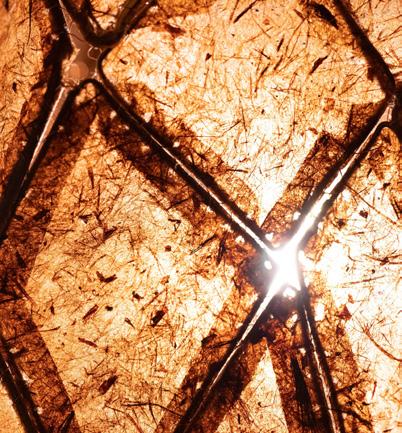
Joel Gregory
PRODUCTION
Connie Jeung-Mills

PHOTOGRAPHY
Nicholas Lea Bruno
CONTRIBUTORS
Nina Lewallen Hufford
Barbara Jones
Stephanie Smith
Lindsay Wright
